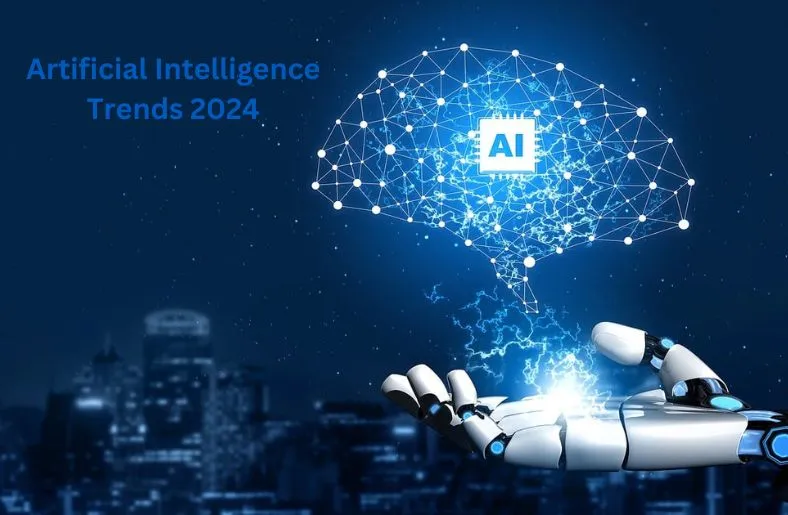As we usher in the new year, the realm of artificial intelligence (AI) continues to evolve at an unprecedented pace, unveiling groundbreaking innovations and transformative trends. In 2024, the landscape of AI promises to be dynamic and thrilling, with emerging technologies poised to reshape industries and redefine human-machine interactions. From advancements in natural language processing and computer vision to the proliferation of AI-driven automation and ethics-driven AI, the top trends in artificial intelligence for 2024 are set to captivate enthusiasts, businesses, and technologists alike. Join us as we explore AI’s cutting-edge developments and transformative potential in the year ahead.
Artificial Intelligence (AI) is one of the fastest-growing fields, offering vast career opportunities across industries. As businesses increasingly integrate AI-driven solutions to enhance efficiency and innovation, demand for skilled AI professionals continues to surge. Pursuing an artificial intelligence online course provides a structured pathway to
acquire essential knowledge and skills required in this burgeoning field. These courses cover foundational concepts including deep learning, machine learning, natural language processing, and computer vision, empowering learners to understand AI algorithms, tools, and techniques. Additionally, these courses hands-on projects and real-world case studies enable students to gain practical experience, preparing them to tackle complex AI challenges and contribute meaningfully to advancing AI-driven innovation.
Generative AI has entered its “hobbyist” phase, mirroring the trajectory of computers, aiming for greater performance in smaller packages. In 2023, there was a surge in efficient foundation models with open licenses, such as Meta’s LlaMa family and others like StableLM, Falcon, Mistral, and Llama 2. DeepFloyd and Stable Diffusion have achieved similar levels of performance as leading proprietary models. Through fine tuning techniques and community-developed datasets, open models rival or surpass closed-source counterparts on many benchmarks despite smaller parameter counts. While media attention often focuses on state-of-the-art model capabilities, the most impactful developments may lie in governance, middleware, training techniques, and data pipelines, ensuring generative AI’s trustworthiness, sustainability, and accessibility for enterprises and end-users.
What is Artificial Intelligence?
Reality check: more realistic expectations: As AI continues to mature, there’s a growing emphasis on setting realistic expectations. Stakeholders are recognizing the limitations and challenges of AI technologies, prompting a shift towards more pragmatic approaches and away from overhyped claims.
Multimodal AI: Multimodal AI integrates multiple modes of input, such as text, images, and voice, to create more comprehensive and context-aware AI systems. This trend enables AI to understand and generate content across different modalities, enhancing user experiences and enabling new applications like multimodal search and content
generation.
Model optimization is getting more accessible: With advancements in model optimization techniques and tools, optimizing AI models for performance, efficiency, and deployment is becoming more accessible to developers and organizations. This trend facilitates the creation of leaner and more efficient AI models, improving scalability and reducing resource requirements.
Customized local models and data pipelines: Organizations are increasingly leveraging customized AI models and data pipelines tailored to their specific needs and infrastructure. This trend allows for greater flexibility, control, and optimization, enabling organizations to extract valuable insights from their data while addressing privacy,
security, and compliance requirements.
Small(er) language models and open-source advancements: In response to concerns about the environmental impact and ethical implications of large language models, there’s a growing focus on developing smaller, more efficient alternatives. Open-source initiatives and advancements in model compression techniques are driving the development of lightweight language models that maintain high performance while
minimizing resource usage.
GPU shortages and cloud costs: The growing demand for AI computing resources, coupled with supply chain disruptions and increasing cloud costs, is leading to challenges such as GPU shortages and rising infrastructure costs. Organizations are exploring strategies to mitigate these challenges, including optimizing resource usage,
exploring alternative hardware solutions, and leveraging hybrid and multi-cloud architectures.
Regulation, copyright, and ethical AI concerns: As AI technologies become more pervasive, regulators and policymakers are grappling with issues related to privacy, data protection, fairness, and accountability. There’s a growing push for regulations and standards to address these concerns, along with increased scrutiny of AI systems
compliance with ethical principles and copyright laws.
Shadow AI (and corporate AI policies): Shadow AI refers to the unauthorized or unmonitored use of AI technologies within organizations, posing risks such as security vulnerabilities, data breaches, and regulatory non-compliance. Organizations are implementing corporate AI policies and governance frameworks to manage and mitigate these risks, ensuring responsible and ethical AI deployment.
More powerful virtual agents: Virtual agents, including chatbots and virtual assistants, are becoming increasingly sophisticated and capable thanks to advancements in natural language processing, conversational AI, and machine learning. These virtual agents are being deployed across various industries to automate customer service, provide personalized assistance, and streamline business processes, enhancing user experiences and driving operational efficiency.
The Artificial Intelligence trends 2024 reflect a maturing AI landscape characterized by a focus on realism, multimodal capabilities, optimization, customization, ethics, and governance. These trends are shaping the future of AI technologies and driving innovation across industries, paving the way for more responsible, efficient, and
impactful AI applications.
Conclusion
The top Artificial Intelligence trends of 2024 offer a glimpse into the evolving landscape of AI, showcasing opportunities for innovation and growth. Pursuing an artificial intelligence online course is instrumental in acquiring the knowledge and skills necessary for a successful career in AI. These courses provide comprehensive training in AI fundamentals, tools, and techniques, preparing individuals to tackle real-world challenges. Moreover, by fostering a culture of lifelong learning, AI courses empower professionals to stay abreast of the latest trends and advancements in the field, ensuring continued relevance and adaptability in an ever-changing technological landscape.





